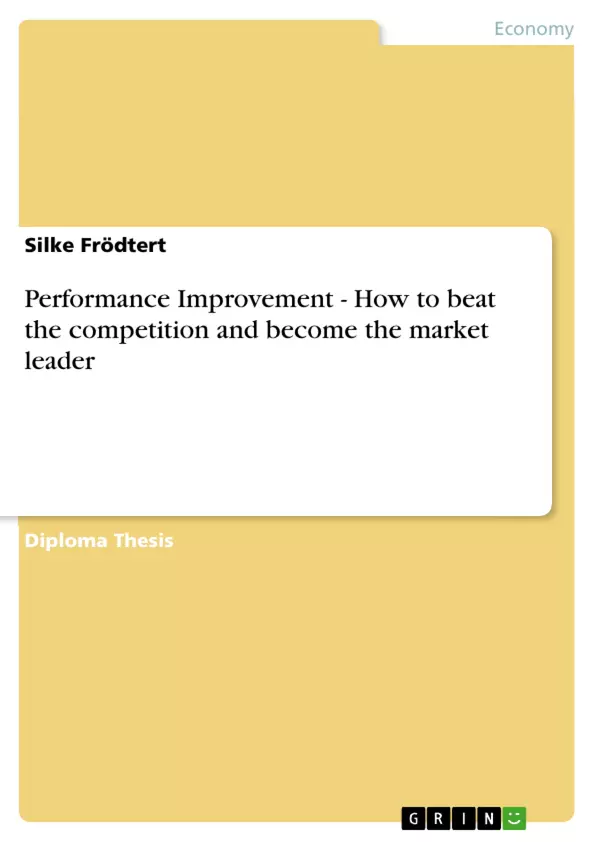Die Arbeit beschreibt den Prozess des Performance Improvements an dem Beispiel vom Joint Venture zwischen Siemens und Dräger Medical. Die Diplomarbeit bietet ein Rahmenwerk um Veränderungen zu managen. Angefangen von einer gemeinsamen Unternehmenskultur bis hin zur Entwicklung von Performance Improvement Strategien und ihrer Implementation.
Inhaltsverzeichnis (Table of Contents)
- 1 Introduction
- 1.1 Problem formulation
- 1.2 Thesis Objectives
- 1.3 Thesis Methodology
- 2 Important Definitions
- 2.1. Performance
- 2.2. Improvement
- 2.3. Market leader
- 2.4. Measures
- 2.4.1. financial measures
- 2.4.2. non-financial measures
- 3 Dräger Medical – A Dräger and Siemens Company
- 3.1. Before the Joint Venture
- 3.2. Reasons for the Joint Venture
- 3.3. After the Joint Venture
- 4 The Competitive Environment
- 5 Framework for managing change
- 5.1. Culture
- 5.2. Mission
- 5.3. Vision
- 5.4. Strategy
- 5.5. Structure
- 5.6. Goals and Objectives
- 6 Evaluation of strategic options
- 6.1. Analyze the past
- 6.2. Analyze the present
- 6.3. Forecasting the future
- 6.4. Establish strategy alternatives
- 6.5. Evaluate alternative strategies
- a) Financial acceptability
- b) External and internal acceptability
- c) Feasibility
- d) Suitability and Fit
- 6.6. Select best alternative
- 6.7. Strategy implementation
- 7. Improvement concepts in selected Key Areas
- 7.1. Dräger Group level
- 7.2. Dräger Medical subgroup level
- 7.3. Business Unit Monitoring
- 7.1.1. Marketing Product Management
- 7.1.2. Business Development
- 8. Measuring the Improvement
- 8.1. The Balance Scorecard approach
- 8.2. First results
Zielsetzung und Themenschwerpunkte (Objectives and Key Themes)
This diploma thesis explores the concept of performance improvement in the context of a company aiming to become a market leader. It analyzes the case of Dräger Medical, a joint venture between Dräger and Siemens, and examines the strategies employed to achieve competitive advantage. The key themes explored in this work are:- Performance improvement strategies for companies seeking market leadership
- The impact of joint ventures on performance and competitive advantage
- Framework for managing change and its elements (culture, mission, vision, strategy, structure, goals and objectives)
- Evaluation of strategic options, including financial, external, internal, and feasibility assessments
- The role of Business Unit Monitoring and key areas for improvement within a company
Zusammenfassung der Kapitel (Chapter Summaries)
- Chapter 1: Introduction: This chapter sets the stage for the thesis by outlining the problem formulation, objectives, and methodology. It establishes the context for the research and identifies the key questions to be addressed.
- Chapter 2: Important Definitions: This chapter provides essential definitions related to performance, improvement, market leadership, and the measures used to assess progress. It clarifies the key concepts that underpin the analysis.
- Chapter 3: Dräger Medical – A Dräger and Siemens Company: This chapter focuses on the history of Dräger Medical, highlighting the events leading up to the joint venture between Dräger and Siemens, the reasons behind the partnership, and the impact of the merger on the company's performance and strategy.
- Chapter 4: The Competitive Environment: This chapter examines the competitive landscape in which Dräger Medical operates. It analyzes the strengths and weaknesses of competitors, identifies industry trends, and explores the opportunities and challenges presented by the market.
- Chapter 5: Framework for Managing Change: This chapter delves into the critical components of a successful change management framework. It explores the interconnected elements of culture, mission, vision, strategy, structure, goals, and objectives, and examines how these elements influence performance improvement.
- Chapter 6: Evaluation of Strategic Options: This chapter presents a framework for evaluating strategic options, taking into account both financial and non-financial factors. It outlines the steps involved in analyzing past performance, assessing the present situation, forecasting future trends, developing alternative strategies, and selecting the best course of action.
- Chapter 7: Improvement Concepts in Selected Key Areas: This chapter explores specific improvement concepts within key areas of the company, such as marketing product management, business development, and overall business unit monitoring. It identifies areas for potential improvement and provides practical recommendations for optimizing operations.
- Chapter 8: Measuring the Improvement: This chapter examines the use of the Balanced Scorecard approach to measure the effectiveness of the implemented improvement strategies. It presents the rationale behind this methodology and outlines the initial results obtained.
Schlüsselwörter (Keywords)
The key focus areas of this diploma thesis include performance improvement, market leadership, joint ventures, strategic management, change management, competitive advantage, business unit monitoring, and the Balanced Scorecard approach. These keywords highlight the central themes and concepts explored within the work.
Fin de l'extrait de 144 pages
- haut de page
- Citation du texte
- Dipl. Betriebswirtin Silke Frödtert (Auteur), 2004, Performance Improvement - How to beat the competition and become the market leader, Munich, GRIN Verlag, https://www.grin.com/document/186047
Lire l'ebook



